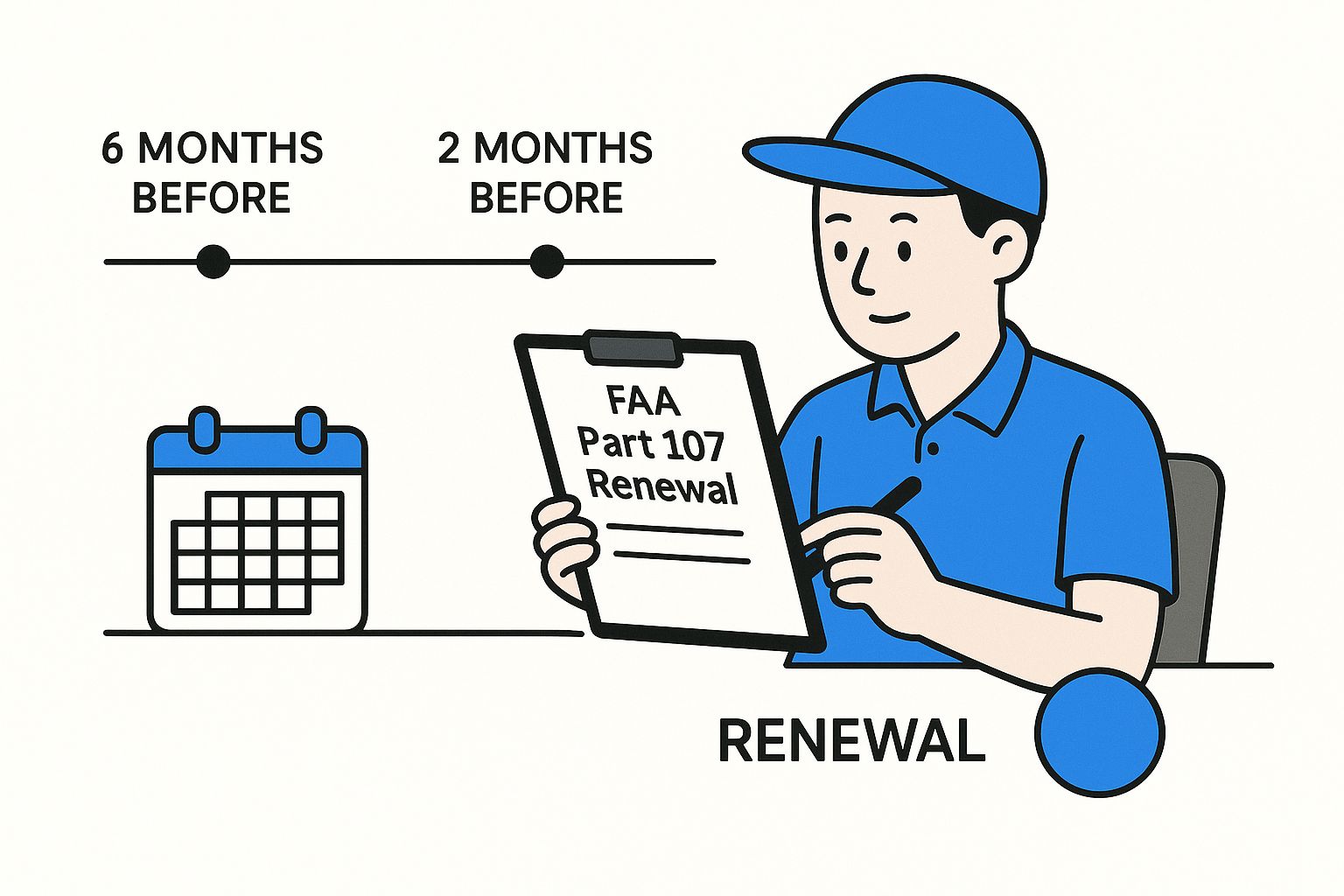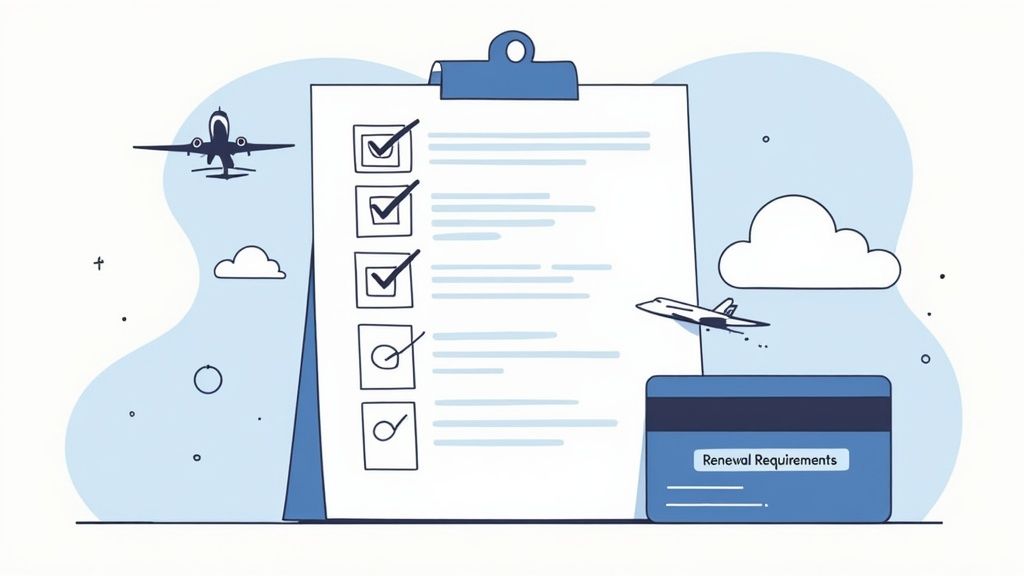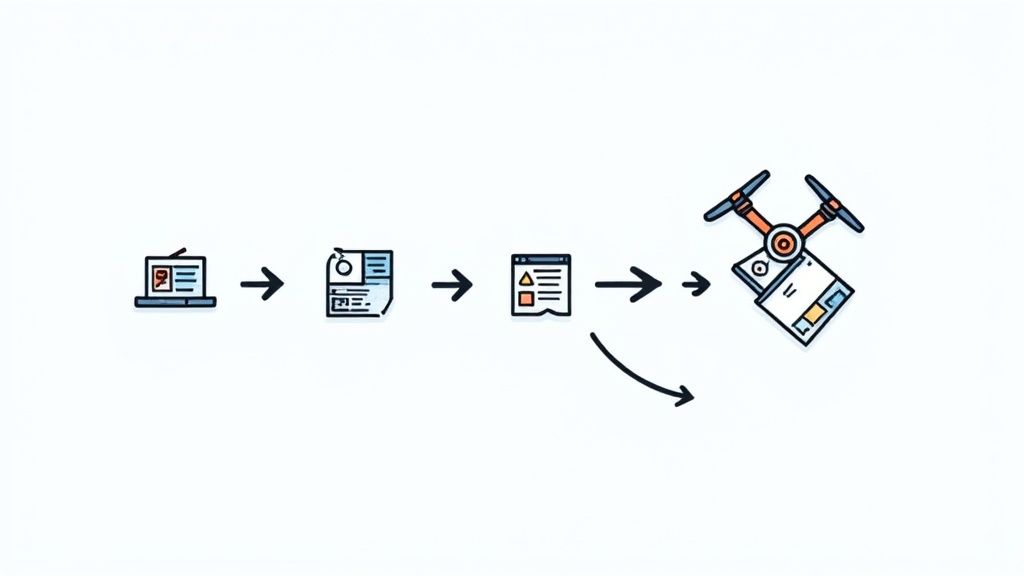FAA Part 107 Renewal Guide: Simplify Your Recertification
- James Baptiste

- May 17
- 11 min read
Updated: May 20
Understanding Your Part 107 Renewal Requirements
Maintaining your FAA Part 107 certification is crucial for continuing commercial drone operations. This certification, essential for pilots of small unmanned aircraft systems (sUAS) weighing under 55 pounds, must be renewed every two years. This ensures continued operational compliance. The renewal process is more than a formality. It's an opportunity to refresh your knowledge and stay updated on drone flight regulations.

As the infographic shows, staying on top of your renewal timeline is key. Understanding the 24-month validity and planning for renewal prevents lapses in your authorization. This proactive approach ensures a seamless transition and avoids interruptions to your commercial drone activities. The FAA Part 107 certification maintains a moderately challenging standard.
In 2024, an average of 67,576 individuals took the FAA Small Unmanned Aircraft Test. The pass rate was 84.2% with an average score of 79.95%. This highlights the importance of ongoing education for operators seeking renewal. For more detailed statistics, check out this article: The Average Score on the Part 107 Test Is Pretty Bad.
Key Differences Between Initial Certification and Renewal
Both processes involve demonstrating competency, but there are differences. The initial exam establishes a baseline of knowledge. This covers regulations, airspace, weather, and emergency procedures. The renewal process focuses on updated or clarified regulations. This ensures you're operating with the most current information.
Focusing on Recurrent Knowledge
The recurrent knowledge test is central to Part 107 renewal. It assesses your understanding of recent regulatory changes and reinforces core principles. This ensures compliance with evolving drone regulations. Recent updates might include airspace restrictions, night flying protocols, or remote identification requirements. Understanding these changes is about operating safely and responsibly. You might also be interested in: Our Sitemap of blog categories.
Consequences of Flying With an Expired Certificate
Flying commercially with an expired Part 107 certificate has serious consequences. These can include fines and potential legal action. It also jeopardizes your professional reputation and the drone industry's safety. Keeping your certification current is a legal, professional, and ethical responsibility.
Navigating the Renewal Process Like a Pro

Renewing your FAA Part 107 license doesn't have to be complicated. By understanding the steps and timelines, you can easily maintain your certification and keep flying. This allows you to concentrate on what truly matters: using your drone for commercial work.
Managing Your FAADroneZone Account
Your FAADroneZone account is the central hub for your Part 107 license. Keeping your information current is vital for a smooth renewal. Make sure your contact details, physical address, and email are accurate. This ensures you'll receive important updates and avoid any processing delays.
Scheduling Your Recurrent Knowledge Test
Just like renewing a domain name, you must renew your Part 107 before it expires. Scheduling your recurrent knowledge test in advance is important. Testing centers often book up, so plan ahead. The FAA website lists approved testing locations nationwide; pick one that’s convenient for you.
Streamlining Your Application Process
Accuracy is key when completing your renewal application. Double-check all the information to avoid errors that can cause delays. This includes verifying your personal details, pilot certificate number, and any other required information. Accurate information ensures a fast turnaround time.
Understanding Timelines and Documentation
Staying on top of deadlines is essential for continued operation. The 24-month validity of the Part 107 license is important to remember. Keep track of your initial certification date to calculate your renewal date. To help illustrate the process, the following table provides a clear timeline.
The table below, "FAA Part 107 Renewal Process Timeline," provides a chronological breakdown of the renewal process, highlighting important deadlines and actions.
Timeframe | Required Action | Important Notes |
|---|---|---|
60 days before expiration | Begin studying for the recurrent knowledge test | Give yourself ample time to review the material |
30 days before expiration | Schedule your recurrent knowledge test | Testing centers can book up, so schedule early |
Two weeks before expiration | Submit your renewal application through FAADroneZone | Ensure all information is accurate and up-to-date |
This table summarizes the key steps and deadlines to ensure a seamless renewal process. Remember to plan ahead and stay organized to avoid any last-minute rushes.
Handling Special Situations
Life throws curveballs, and sometimes changes occur that impact your certification. Name changes, address updates, or changes in medical status may require additional documentation. Contact the FAA directly for guidance on specific requirements. Addressing these situations promptly prevents potential complications.
Tips from Seasoned Pilots
Stay organized: Keep copies of all your important documents, including your original certificate, test scores, and any FAA correspondence.
Utilize online resources: The FAA website is a valuable source of information on Part 107 renewal requirements.
Join online communities: Connecting with other drone pilots allows you to learn from shared experiences.
By following these tips and staying organized, you can ensure a smooth FAA Part 107 renewal process, allowing you to continue operating commercially without interruption.
Mastering the Recurrent Knowledge Test

Renewing your FAA Part 107 license requires passing the recurrent knowledge test. This isn't a simple review; it demands a focused approach to refresh your understanding and adapt to any regulatory updates. Think of it as a refresher course for your drone piloting skills.
Key Knowledge Areas to Focus On
The recurrent knowledge test covers vital areas for safe drone operations. Mastering these topics boosts your confidence and improves your test performance.
Airspace Regulations: Understanding airspace classifications and restrictions is essential. Knowing how to interpret airspace maps and identify legal flying zones is key.
Weather Interpretation: Weather significantly impacts drone flight. You must interpret weather reports, identify hazardous conditions, and make informed flight safety decisions.
Emergency Procedures: Knowing how to react in emergencies is crucial. This includes understanding lost-link procedures, equipment malfunctions, and handling unforeseen events.
Operational Limits: Operating within legal limits is paramount. This includes weight and altitude restrictions, and maintaining visual line of sight.
Effective Study Strategies for Recertification
Simply rereading the material isn't sufficient. Effective pilots use proven study strategies for better knowledge retention. This targeted approach allows for efficient preparation.
Practice Questions: Regular practice with sample questions helps you become familiar with the format and pinpoint weaker areas.
Focused Review: Concentrate on areas where you struggle to strengthen your overall understanding.
Stay Updated: Keep up with any recent regulatory changes to ensure you're current with the latest requirements.
Addressing Knowledge Gaps and Regulatory Changes
It's normal for knowledge to fade over time. Actively identifying and addressing any gaps since your initial certification is vital for test preparation.
Regulatory changes are constant in the drone industry. Understanding how these changes appear in the testing process is important. In 2021, the FAA saw nearly 99,000 average monthly cumulative drone registrations and approximately 712 average monthly remote pilot certificate renewals. 'Renew+', covering post-expiry or late renewals, averaged about 1,780 per month. Detailed statistics are available from the FAA. These numbers demonstrate the commitment of drone pilots to maintaining certification. Preparing for the FAA Part 107 renewal involves more than just review; it's a strategic process of refreshing core knowledge and adapting to evolving regulations. By focusing on key areas, using smart study techniques, and staying updated, you can approach your renewal confidently and continue your commercial drone operations seamlessly. You can also explore our sitemap for additional resources.
Critical Regulatory Updates You Can't Afford to Miss
Staying ahead of the curve with FAA Part 107 renewal involves more than just understanding the renewal process. It requires staying informed about the constantly changing regulations that affect how you operate your drone every day.
Airspace Restrictions: Navigating the Complexities
Airspace regulations are always being updated, with new restrictions and classifications appearing regularly. For instance, temporary flight restrictions (TFRs) can be put in place quickly due to events like wildfires or VIP movements. Knowing how to find and understand real-time airspace information is vital for compliance. This involves regularly checking resources like the FAA's B4UFLY app and staying aware of potential restrictions in your area of operation.
Night Operations and Flights Over People: Expanding Your Operational Window
Recent updates have opened up more opportunities for night operations and flights over people, but these come with more stringent rules. Night operations now require specific lighting and training. Flights over people are categorized into different operations with varying equipment and operational limitations. These changes provide new opportunities for commercial drone pilots, but also highlight the importance of careful planning and following the updated regulations. Check out our guide on site map for more info about drones and flight regulations.
Remote ID: Broadcasting Your Drone's Identity
Remote ID has become a core part of drone regulation, mandating that drones transmit their identification and location. This technology improves safety and security by increasing transparency in the airspace. Making sure your drone has compliant remote ID technology is a fundamental requirement for FAA Part 107 operations. For helpful tips on the recurrent knowledge test, take a look at DroneDesk's article on the Part 107 Recurrent Test.
Anticipating Future Requirements: Staying Ahead of the Game
The drone industry is constantly evolving. According to FAA data and aerospace forecasts, the demand for Part 107 commercial drone operations is projected to increase significantly. By the end of 2023, there were approximately 2,311 actively registered light unmanned aircraft systems (lUAS) under Part 107, factoring in a 16% delisting rate. Projections anticipate roughly 14,859 new lUAS registrations by 2028. You can find more information about drone registrations. Staying informed about proposed regulatory changes is essential. Monitoring FAA announcements and taking part in industry conversations helps you prepare for future requirements before they affect your work. By understanding these evolving regulations, you'll be better prepared to succeed in the dynamic world of commercial drone operations. This proactive approach will help you continue to thrive as the industry grows.
Overcoming Common Renewal Roadblocks
Even seasoned drone pilots can encounter unexpected hurdles when renewing their FAA Part 107 certification. This section offers practical solutions to the most common obstacles, ensuring you can maintain your certification and continue your commercial operations.
Last-Minute Scheduling Difficulties
Life can get hectic, and scheduling your recurrent knowledge test might slip your mind. If you’re facing a time crunch, contact your local testing centers directly. Explain your situation – they may have cancellations or alternative testing times available. Consider traveling to a less busy testing location if needed. Flexibility is key.
Knowledge Test Anxiety
Test anxiety is normal, even for experienced pilots. To minimize stress, prepare thoroughly using practice tests and focus on key knowledge areas. Simulate the test environment while studying to acclimate yourself to the format and pressure. Remember: the renewal test emphasizes updated regulations and core concepts.
Documentation Problems
Missing or incorrect documentation can cause significant delays. Keep organized digital and physical copies of all important documents, including your original certificate, test scores, and any communication with the FAA. Double-check all information entered into the FAADroneZone portal for accuracy. Meticulous record-keeping is crucial.
FAADroneZone Navigation Challenges
Navigating the FAADroneZone portal can be complex. If you're having trouble, contact the FAA directly for support. They have staff dedicated to assisting you through the renewal process. Ensure your profile information, including your name and address, is up-to-date to avoid delays.
Certificate Expiration Before Renewal
If your certificate expires before you renew, don't worry. You can still renew, but you'll need to retake the full knowledge test, not just the recurrent version. Completing the test promptly will allow you to regain your certification and resume commercial operations. You might find our event pages sitemap helpful for information on upcoming workshops and webinars.
Administrative Errors or Delays
Occasionally, errors occur, or processing takes longer than anticipated. If you suspect an administrative error or experience unusual delays, contact the FAA directly. Providing clear documentation of your renewal process will expedite issue resolution. Detailed records of your application, test scores, and FAA communications will be invaluable.
By understanding and preparing for these common challenges, you can simplify your FAA Part 107 renewal process. This proactive approach allows you to maintain continuous commercial operations and focus on your drone business goals.
Leveraging Your Part 107 Certification for Business Growth
Your Part 107 certification isn't just a license; it's a key to unlocking business opportunities in the growing drone market. This section explores how to maximize its potential, from spotting lucrative opportunities to setting yourself apart from the competition.
Identifying Lucrative Opportunities
The commercial drone industry is brimming with possibilities for certified pilots. Several sectors are experiencing rapid growth, creating a demand for skilled drone operators.
Inspections: Industries like construction, energy, and infrastructure require frequent inspections. Drones provide efficient and cost-effective solutions.
Photography & Videography: Aerial perspectives are highly sought after, from real estate to filmmaking. Part 107 pilots can offer specialized aerial imaging services.
Agriculture: Precision agriculture is increasingly relying on drones. They monitor crop health, assess field conditions, and optimize resource use.
Public Safety: Drones assist law enforcement and emergency services with search and rescue, surveillance, and disaster response efforts.
To further illustrate the potential of a Part 107 license, let's look at some specific applications across different industries. The following table provides a brief overview:
Commercial Drone Applications by Industry
Overview of lucrative commercial drone applications across different industries for Part 107 certified pilots
Industry | Applications | Growth Potential | Certification Requirements |
|---|---|---|---|
Construction | Inspections, progress monitoring, site surveys | High | Part 107 + specialized training (e.g., thermal imaging) |
Energy | Wind turbine inspections, pipeline surveys, power line inspections | High | Part 107 + specialized training (e.g., infrared thermography) |
Real Estate | Aerial photography, videography, virtual tours | Medium | Part 107 |
Filmmaking | Aerial cinematography, behind-the-scenes footage | Medium | Part 107 + specialized camera operation skills |
Agriculture | Crop monitoring, precision spraying, field mapping | High | Part 107 + specialized software knowledge (e.g., drone mapping software) |
Public Safety | Search and rescue, surveillance, accident reconstruction | Medium | Part 107 + specific agency authorizations |
This table highlights the diverse applications and growth potential across several key sectors. Note that specialized training beyond the basic Part 107 can significantly increase your earning potential.
Differentiating Your Services
The drone market is becoming more competitive. Standing out is essential for success. Consider specializing in a niche, like thermal imaging for inspections or cinematic drone videography. Offering bundled services, such as data analysis and reporting along with aerial data collection, can also make your business more attractive.
Showcasing Your Credentials
Building trust with potential clients starts with showcasing your qualifications. Highlight your Part 107 certification on your website and marketing materials. Testimonials and a strong portfolio featuring successful projects build credibility. Case studies demonstrating the value you bring to clients are particularly effective. Check out our blog posts sitemap for more information.
Building on Your Basic Certification
Enhance your marketability with additional certifications and specializations, such as advanced drone operations like beyond visual line of sight (BVLOS) flight, or specialized camera operations like LiDAR scanning. These advanced skills open doors to more complex and higher-paying projects.
Networking and Staying Engaged
Networking within the drone industry is vital for long-term success. Attend industry events, join online communities, and participate in workshops. Staying up-to-date on emerging trends and regulatory changes is also crucial for adapting to the evolving landscape and anticipating future opportunities. This includes keeping abreast of new technologies, operational advancements, and regulatory updates.
Future-Proofing Your Part 107 Operations
The drone industry is constantly changing, and regulations are evolving alongside it. Your FAA Part 107 renewal isn't just about recertification; it's about staying informed and adapting to the future of drone operations.
Emerging Trends Reshaping Part 107
Several key trends are shaping Part 107 requirements and commercial drone operations. The FAA is actively working on integrating drones into the national airspace. This will likely lead to changes in testing, focusing on more advanced operational scenarios. We can also anticipate new certification categories as drone technology diversifies, potentially requiring specialized licenses for different operations.
Technological Advancements Influencing Regulations
Technology is driving regulatory evolution. Detect-and-Avoid (DAA) systems are becoming more sophisticated. As DAA technology matures, regulations will likely adapt to accommodate more complex operations, including Beyond Visual Line of Sight (BVLOS) flights. Understanding DAA technology will be crucial for future Part 107 renewals.
Remote ID, which broadcasts a drone's identification and location, is also becoming standard. This enhances safety and security, and will be a focus in future regulations. UTM (Unmanned Traffic Management), which manages drone traffic safely and efficiently, is another key development shaping the industry.
Developing Valuable Skills for the Future
As advanced operations like BVLOS, drone delivery, and urban air mobility gain traction, certain skills are becoming essential. Future Part 107 renewals may incorporate assessments of these skills.
BVLOS Operation: Expertise in operating drones beyond visual line of sight will be crucial for many commercial applications.
UTM Principles: Understanding and implementing UAS Traffic Management (UTM) will be essential for operating in complex airspace.
Staying current with these trends is critical for commercial operators.
Adapting to Evolving Regulations
The regulatory landscape is dynamic. The FAA's integration roadmap for drones suggests a move towards a more integrated airspace. Adapting to evolving regulations will be an ongoing process.
Keeping up with changes through resources like the FAA website and industry publications will be crucial. Proposed changes to Part 107, such as those related to BVLOS operations, will further shape the future of commercial drone operations. Understanding these changes and their impact on your operations allows you to anticipate evolving requirements. By anticipating trends, you can invest in appropriate training and technology, ensuring your skills and equipment remain compliant. Engaging with industry groups and participating in discussions surrounding proposed changes can also provide valuable insights.
Ready to take your drone operations further? Visit JAB Drone for expert insights, product reviews, and the latest news.




Comments